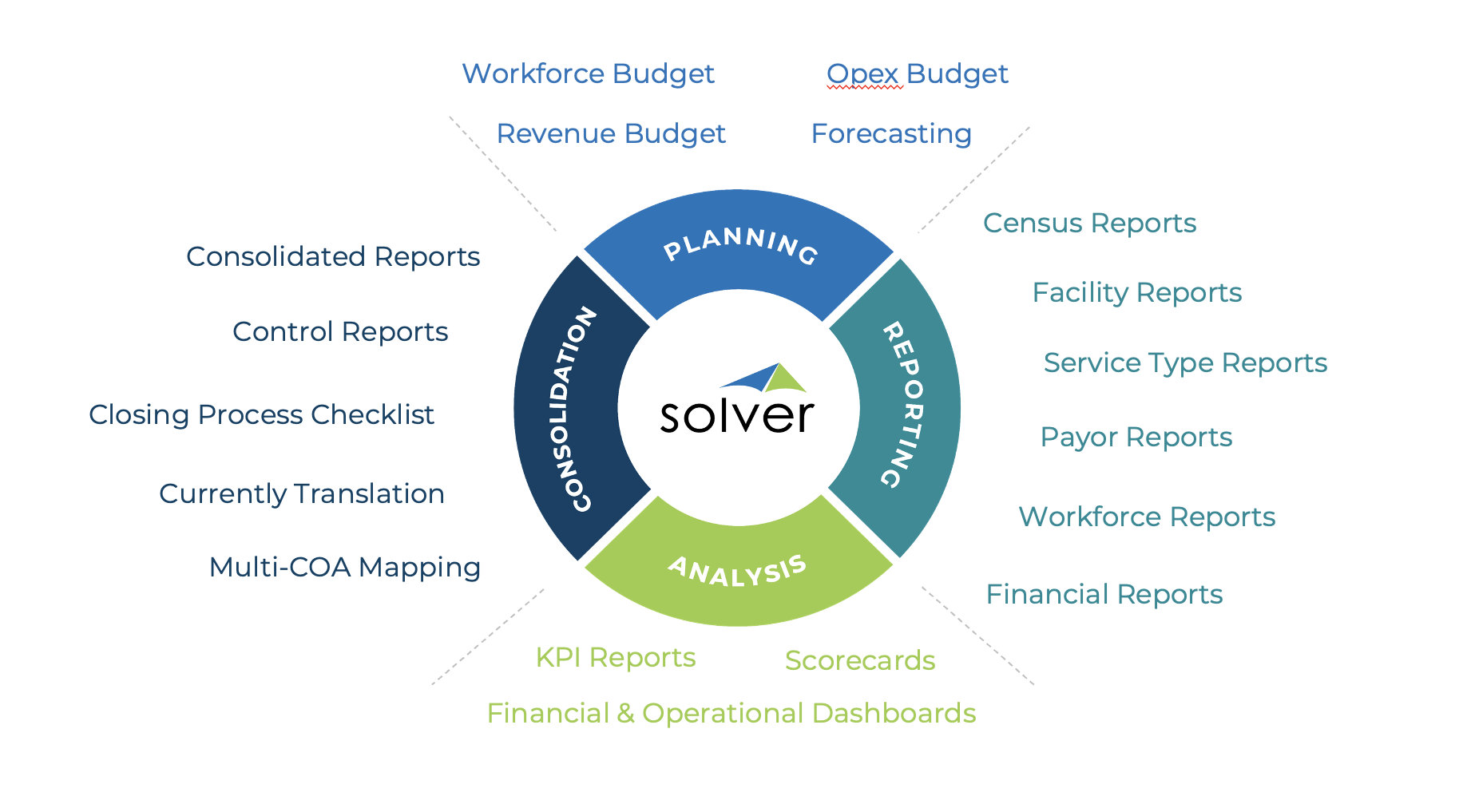Driving Better Decisions with KPIs in Senior Living
Key performance indicators (KPIs) are the heartbeat of strategic decision-making in the Senior Living industry. For holding companies managing multiple facilities, KPIs offer a lens into critical metrics like occupancy rates, revenue per resident, and staffing efficiency. However, without the right tools, leveraging these KPIs effectively can be challenging. Traditional methods, often reliant on manual data collection and disparate systems, can slow down decision-making and lead to missed opportunities.
Modern Financial Planning and Analysis (FP&A) solutions like Solver xFP&A streamline the KPI component of financial and operational reporting, enabling faster, more informed decisions. But what happens when companies rely on outdated or fragmented reporting systems? Let’s explore the key challenges and how adopting a robust KPI-driven FP&A platform can transform financial reporting in the Senior Living industry.

Challenges in KPI Reporting Without Modern FP&A Software
In the Senior Living industry, the ability to track and analyze KPIs is critical for maintaining both operational efficiency and financial health. However, many holding companies still rely on traditional reporting methods that can’t keep pace with the complexity and scale of multi-facility operations. Without a modern FP&A solution in place, reporting becomes a time-consuming and fragmented process, leading to a host of challenges that can impede timely decision-making and strategic focus. Below are some of the most common obstacles faced when companies lack the right tools to streamline KPI reporting.
- Fragmented Data Sources and Inconsistent Reporting Standards
Senior Living companies often rely on data from various sources—ERP systems, payroll, and operational databases—that may not communicate well with each other. Without a centralized platform, data silos emerge, leading to inconsistent reporting standards across facilities. This makes it difficult for executives to get a unified view of performance, causing delays and potential inaccuracies in reporting. - Time-Consuming Manual Processes
In the absence of automation, finance teams spend countless hours gathering, reconciling, and analyzing data manually. This labor-intensive process can delay monthly financial reports, leaving decision-makers with outdated information. Moreover, the time spent on manual processes takes away from higher-value tasks like strategic analysis and planning. - Lack of Real-Time Insights
Static reports, often delivered days or weeks after the close of a period, hinder the ability to respond quickly to emerging issues. In a dynamic industry like Senior Living, where occupancy rates or staffing needs can fluctuate rapidly, having real-time insights is crucial to making proactive decisions. Without live dashboards, executives may miss early warning signs of underperformance. - Difficulty in Identifying Trends and Variances
Traditional reporting tools lack the analytical depth needed to easily identify trends, variances, and outliers. Understanding why revenue per resident is below expectations or why certain facilities have higher staff turnover requires detailed drill-down capabilities that legacy systems often don’t provide. This leads to reactive rather than proactive management. - Misalignment Between Financial and Operational Goals
When KPIs are not aligned with strategic objectives, decision-makers may focus on metrics that don’t drive the company’s goals. Without a modern FP&A solution that connects financial and operational data, it’s challenging to ensure that every KPI ties back to broader organizational priorities, potentially leading to misdirected efforts and missed opportunities.

Benefits of Implementing Modern FP&A Software with Strong KPI Capabilities
Overcoming the challenges of fragmented data and manual processes requires more than just effort—it demands the right technology. Modern FP&A solutions like Solver are purpose-built to address these pain points, transforming how Senior Living organizations manage KPIs. By leveraging automation, real-time dashboards, and advanced analytics, these platforms not only streamline financial and operational reporting but also align performance metrics with strategic goals. Let’s explore the key benefits that come with implementing a robust FP&A solution with strong KPI capabilities.

Here are the key benefits:
- Centralized Data for Consistent Reporting
Modern FP&A solutions like Solver bring all financial and operational data into one platform, ensuring consistent reporting standards across all facilities. By consolidating data from ERP, payroll, and CRM systems, Solver provides a single source of truth, enabling executives to view performance metrics in a unified, accurate format. - Automation for Increased Efficiency
Automation eliminates the need for manual data collection and reconciliation, allowing finance teams to focus on analysis rather than data entry. Solver’s pre-built templates and automated workflows accelerate the reporting process, ensuring that monthly financial reports are delivered on time and with minimal effort. - Real-Time Dashboards for Proactive Decision-Making
Solver’s interactive dashboards provide real-time insights into key metrics, enabling executives to spot trends and variances as they happen. For example, if occupancy rates drop at a specific facility, leaders can investigate and address the issue immediately, rather than waiting until the next reporting cycle. - Advanced Analytical Capabilities
Solver’s customizable KPI dashboards allow users to drill down into specific metrics to uncover the root causes of performance variances. This level of detail empowers decision-makers to identify best practices, address inefficiencies, and benchmark performance across different facilities, ensuring continuous improvement. - Alignment of KPIs with Strategic Goals
With Solver, companies can align financial and operational KPIs with their strategic objectives, ensuring that every metric tracked contributes to the organization’s broader goals. This alignment fosters a culture of accountability and ensures that all departments are working toward the same priorities, enhancing overall performance.

Examples of KPI use in the Monthly Financial Reporting Process
Here are some examples of how companies use KPIs in their monthly financial reporting process:
- Data Collection
- Gather financial data from ERP, payroll, and billing systems.
- Collect operational data such as resident occupancy rates, staff hours worked, and care levels.
- Data Validation and Consolidation
- Ensure the accuracy of financial data, including revenue from resident fees and expenses like payroll and supplies.
- Consolidate operational data across multiple senior living facilities for a comprehensive view.
- KPI Calculation
- Calculate key KPIs such as:
- Occupancy Rate (%): Actual resident occupancy compared to available capacity.
- Revenue per Occupied Unit (RPU): Revenue generated per resident.
- Payroll as a Percentage of Revenue: Total payroll costs divided by total revenue.
- Resident Care Hours per Day: Average hours of care provided per resident daily
- Calculate key KPIs such as:
- Financial Close
- Complete reconciliations and adjustments for accurate financials.
- Ensure alignment between financial data and KPIs, such as staffing costs correlating with resident care levels.
- KPI Comparison and Analysis
- Compare KPIs to monthly targets and benchmarks, such as expected occupancy rates or payroll efficiency.
- Analyze variances, such as higher-than-expected payroll costs or declining RPU, and identify underlying causes.
- Management Reporting
- Present financial statements alongside KPI dashboards.
- Highlight key insights, such as trends in resident care hours or variances in facility occupancy rates.
- Decision-Making and Follow-Up
- Use KPI insights to inform decisions, such as adjusting staffing levels or launching initiatives to boost occupancy.
- Implement corrective actions where KPIs deviate from targets, ensuring alignment with strategic goals.
By focusing on these Senior Living-specific KPIs, monthly reporting becomes a powerful tool for improving operational efficiency, optimizing resources, and enhancing resident care.
In the fast-paced Senior Living industry, timely and accurate KPI reporting is essential to making informed, strategic decisions. Companies that continue to rely on outdated methods risk falling behind, as manual processes, fragmented data, and delayed insights hinder their ability to respond to challenges and opportunities.
By implementing a modern FP&A solution like Solver, Senior Living organizations can streamline their financial and operational reporting, automate manual tasks, and gain real-time insights into critical KPIs. The result? Faster, more confident decision-making that drives better outcomes for residents, staff, and the business as a whole.
If you’re ready to accelerate better decisions and take your KPI reporting to the next level, Solver xFP&A is here to help. Discover how you can transform your reporting process and unlock the full potential of your Senior Living operations.
